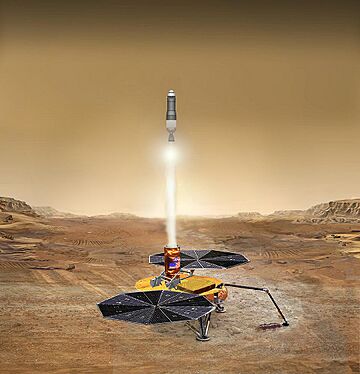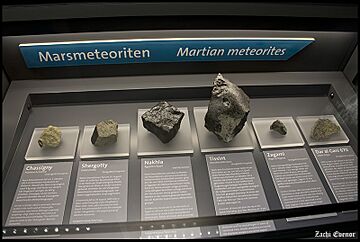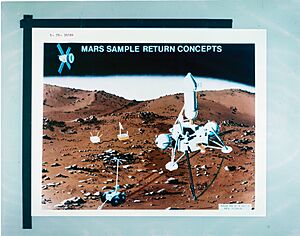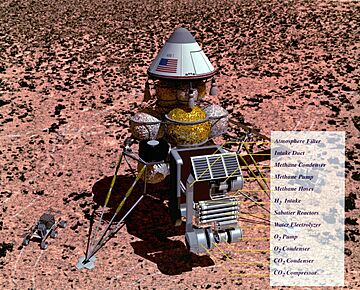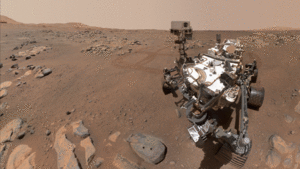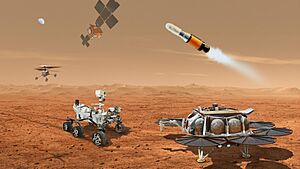Mars sample-return mission facts for kids
A Mars sample-return mission is a super exciting plan to bring pieces of Mars back to Earth! Imagine getting to study real rocks and dust from another planet right here in our labs. Scientists want to collect these samples to learn more about Mars than they can with robots on the planet itself.
Bringing these samples back will help us understand if Mars ever had life, how it formed, and what its future might hold. Even though it sounds like science fiction, this mission is already happening in parts. For example, the Perseverance rover is currently collecting samples on Mars. Scientists are also very careful to make sure any samples brought back are safe and don't bring anything harmful to Earth.
Contents
Why Bring Mars Rocks Home?
Once samples from Mars are on Earth, scientists can study them with the best tools available. These tools are much more powerful than anything we can send to Mars. This allows for many new discoveries in different areas of science.
Scientists can even save some samples for the future. This means they could be studied again years from now, using new instruments that don't even exist yet! This helps us keep learning more over a long time.
Experts agree that bringing samples back is one of the most important steps for exploring Mars. Many big questions about Mars can only be answered by studying real Martian material up close.
Sometimes, rocks from Mars naturally fall to Earth. These are called Martian meteorites. As of 2023, scientists had found over 350 of these space rocks. We know they are from Mars because their makeup is very similar to rocks and gases found on Mars. However, these meteorites are not as good as fresh samples collected directly from Mars. We don't know exactly where on Mars they came from, and they can get changed by their long journey through space and landing on Earth.
A Long-Held Dream: The History of Mars Sample Return
Scientists have dreamed of bringing Mars samples back for a very long time. This idea came up even before humans landed on the Moon or before the first spacecraft flew past Mars. Early plans in the 1970s and 1980s imagined big rockets and complex missions.
Early Ideas and Challenges
In the early 1970s, NASA began studying how to bring samples back. They realized it would need very powerful rockets to lift off from Mars. One early idea was called SCIM (Sample Collection for Investigation of Mars). This plan involved a spacecraft flying through Mars's upper atmosphere to collect dust and air without even landing!
The Soviet Union also planned Mars sample-return missions in the 1970s. However, these missions were canceled because of problems with their rockets and the missions being too complicated.
By the mid-1980s, mission planners knew that bringing samples back would be very expensive and difficult. They thought about sending a large spacecraft from Earth. This spacecraft would include a rover to collect samples and a special vehicle to launch them back into space from Mars.
Renewed Interest and New Plans
After a NASA Mars mission failed in 1993, the United States started a new Mars Exploration Program. This program supported the idea of bringing samples back. In 1996, there was a lot of excitement when scientists thought they found signs of ancient life in a Martian meteorite. Even though this idea was later proven wrong, it made people even more interested in bringing samples directly from Mars.
In the late 1990s, NASA worked on plans for smaller, more affordable missions. They thought about sending a small rocket from Mars that would meet a small orbiter. This orbiter would then bring the samples back to Earth. These plans faced many challenges, including how to make the rockets light enough.
By the late 1990s, NASA hoped to launch sample return missions in 2003 and 2005. These missions would have included rovers and Mars ascent vehicles (MAVs). A French-built orbiter would have collected the samples in Mars orbit and brought them home. However, these plans were canceled after a review.
In 2009, NASA and the ESA started working together on the ExoMars program. Their goal was to return samples from Mars in the 2020s. But this plan also faced budget problems, and NASA later had to pull out of the ExoMars program.
Perseverance and the Mars 2020 Mission
A very important step for Mars sample return happened with the Mars 2020 mission. The Perseverance rover landed in Jezero Crater on Mars in February 2021. This crater is believed to be an ancient lakebed, which makes it a great place to look for signs of past life.
One of Perseverance's main jobs is to collect samples of Martian rocks and soil. It puts these samples into special sealed tubes. So far, it has collected many samples. These tubes are then left on the surface of Mars for a future mission to pick up.
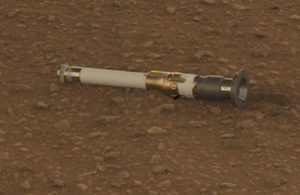
Starting in December 2022, Perseverance began creating a "sample depot" at a place called Three Forks. It deposited 10 of its collected samples there. This is a backup plan. If Perseverance can't deliver the samples directly to a future lander, the samples at the depot can still be picked up.
Who is Planning to Bring Samples Back?
Several space agencies around the world are working on plans to bring Mars samples to Earth.
NASA–ESA
The plan from NASA and the ESA involves three main parts:
- Sample Collection: The Perseverance rover (launched in 2020) is already doing this on Mars.
- Sample Retrieval: A future mission will send a lander to Mars. This lander will have a small rocket to launch the samples into orbit around Mars. It might also have small helicopters to help pick up samples.
- Earth Return: Another spacecraft will orbit Mars, pick up the sample container launched from the surface, and bring it safely back to Earth.
As of 2024, this NASA-ESA plan is still being designed. It has faced challenges with its budget and schedule. NASA is looking for ways to make the mission more affordable and happen sooner.
China
China has announced its own plan for a Mars sample-return mission called Tianwen-3. They aim to launch this mission in late 2028. It would involve two separate launches from Earth. One launch would carry the lander and the rocket to leave Mars. The other would carry the orbiter and the return module. China hopes to bring samples back to Earth by July 2031.
Japan
The Japanese Aerospace Exploration Agency (JAXA) has a plan called Martian Moons Exploration (MMX). This mission aims to collect samples from one of Mars's moons, either Phobos or Deimos. Phobos is very close to Mars, so its surface might have tiny pieces of Mars that were blasted off by impacts. Japan plans to launch this mission in 2026 and return samples to Earth in 2031. Japan is also interested in working with other countries on a Mars sample-return mission.
Russia
Russia has a concept for a Mars sample-return mission called Mars-Grunt. This plan would involve a spacecraft with an orbiter and a lander. A robotic arm on the lander would collect samples from around the landing site.
Keeping Earth Safe: Planetary Protection
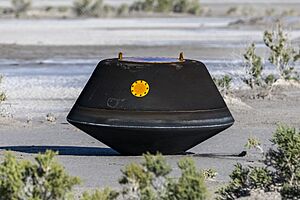
A big question is whether life exists on Mars. If it does, there's a tiny chance that bringing samples back could accidentally bring Martian germs to Earth. This is called "back contamination." Scientists want to make sure Earth's environment is protected.
Most scientists believe the chance of this happening is very, very small. But to be safe, any samples brought back from Mars would be treated as if they could be harmful. They would be kept in very secure containers. The goal is to make sure the chance of any Martian particle escaping is less than one in a million.
There are strict rules and laws in place to protect Earth from any potential contamination. Space agencies must follow these rules. The mission is designed to prevent any contact between the Martian environment and the outside of the sample containers.
When the sample capsule returns to Earth, it will be designed to land safely without a parachute. It will use a special heat shield to cushion its impact. The sample container inside will be very strong to survive the landing. NASA plans to build a special, super-secure lab called a Biosafety Level 4 (BSL-4) facility. This is the highest level of safety for handling dangerous materials, and it would be used to study the Mars samples.
Some scientists believe the risk of contamination is extremely low. They point out that rocks from Mars have naturally fallen to Earth as meteorites for millions of years without causing any known problems. However, other groups have concerns about the safety measures. They suggest more tests should be done on Mars or at the International Space Station before samples come to Earth. Scientists are taking all these concerns seriously and are working hard to make sure the mission is as safe as possible.
See also
- Timeline of Solar System exploration


